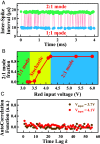Stochastic transition in synchronized spiking nanooscillators
- PMID: 37695901
- PMCID: PMC10515151
- DOI: 10.1073/pnas.2303765120
Stochastic transition in synchronized spiking nanooscillators
Abstract
This work reports that synchronization of Mott material-based nanoscale coupled spiking oscillators can be drastically different from that in conventional harmonic oscillators. We investigated the synchronization of spiking nanooscillators mediated by thermal interactions due to the close physical proximity of the devices. Controlling the driving voltage enables in-phase 1:1 and 2:1 integer synchronization modes between neighboring oscillators. Transition between these two integer modes occurs through an unusual stochastic synchronization regime instead of the loss of spiking coherence. In the stochastic synchronization regime, random length spiking sequences belonging to the 1:1 and 2:1 integer modes are intermixed. The occurrence of this stochasticity is an important factor that must be taken into account in the design of large-scale spiking networks for hardware-level implementation of novel computational paradigms such as neuromorphic and stochastic computing.
Keywords: spiking oscillators; stochastic transition; synchronization evolution; thermal coupling; time domain phase coexistence.
Conflict of interest statement
The authors declare no competing interest.
Figures




Similar articles
-
Integer Factorization with Stochastic Spiking in Percolating Networks of Nanoparticles.ACS Nano. 2024 Oct 15;18(41):28060-28069. doi: 10.1021/acsnano.4c07200. Epub 2024 Oct 3. ACS Nano. 2024. PMID: 39361524
-
Robust synchronization control scheme of a population of nonlinear stochastic synthetic genetic oscillators under intrinsic and extrinsic molecular noise via quorum sensing.BMC Syst Biol. 2012 Oct 26;6:136. doi: 10.1186/1752-0509-6-136. BMC Syst Biol. 2012. PMID: 23101662 Free PMC article.
-
Synchronization, Stochasticity, and Phase Waves in Neuronal Networks With Spatially-Structured Connectivity.Front Comput Neurosci. 2020 Oct 19;14:569644. doi: 10.3389/fncom.2020.569644. eCollection 2020. Front Comput Neurosci. 2020. PMID: 33192427 Free PMC article.
-
A design principle underlying the synchronization of oscillations in cellular systems.J Cell Sci. 2010 Feb 15;123(Pt 4):537-43. doi: 10.1242/jcs.060061. Epub 2010 Jan 26. J Cell Sci. 2010. PMID: 20103537 Review.
-
Thermal Management in Neuromorphic Materials, Devices, and Networks.Adv Mater. 2023 Sep;35(37):e2205098. doi: 10.1002/adma.202205098. Epub 2023 Mar 31. Adv Mater. 2023. PMID: 36067752 Review.
Cited by
-
Purely electronic insulator-metal transition in rutile VO2.Nat Commun. 2025 Jul 1;16(1):5444. doi: 10.1038/s41467-025-60243-0. Nat Commun. 2025. PMID: 40595465 Free PMC article.
-
Collective dynamics and long-range order in thermal neuristor networks.Nat Commun. 2024 Aug 14;15(1):6986. doi: 10.1038/s41467-024-51254-4. Nat Commun. 2024. PMID: 39143044 Free PMC article.
-
Artificial Photothermal Nociceptor Using Mott Oscillators.Adv Sci (Weinh). 2025 Feb;12(6):e2409353. doi: 10.1002/advs.202409353. Epub 2024 Dec 18. Adv Sci (Weinh). 2025. PMID: 39692203 Free PMC article.
-
Local strain inhomogeneities during electrical triggering of a metal-insulator transition revealed by X-ray microscopy.Proc Natl Acad Sci U S A. 2024 Aug 20;121(34):e2317944121. doi: 10.1073/pnas.2317944121. Epub 2024 Aug 15. Proc Natl Acad Sci U S A. 2024. PMID: 39145937 Free PMC article.
References
-
- Pikovsky A., Rosenblum M., Kurths J., Hilborn R. C., Synchronization: A universal concept in nonlinear science. Am. J. Phys. 70, 655–655 (2002).
-
- Chen C., Liu S., Shi X. Q., Chaté H., Wu Y., Weak synchronization and large-scale collective oscillation in dense bacterial suspensions. Nature 542, 210–214 (2017). - PubMed
-
- Herzog E. D., Neurons and networks in daily rhythms. Nat. Rev. Neurosci. 8, 790–802 (2007). - PubMed

